April
19, 1964
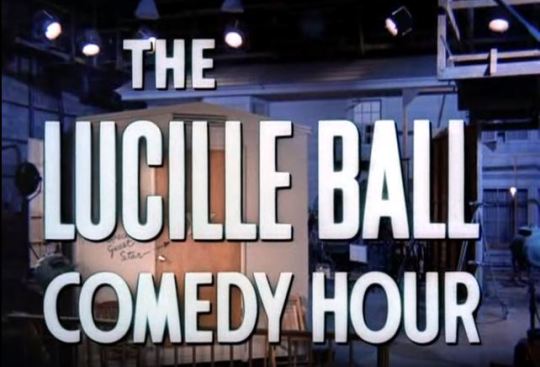

Directed
by Jack Donohue ~ Written by Richard Powell, based on the play by Sherwood Schwartz, with special material by Arthur Julian
Synopsis
Lucille
Ball plays the head of a studio trying to track down Bob Hope to star
in a TV special about husband and wife television stars. The first
half concerns Lucy’s tracking the elusive Hope all around the world.
The second half presents the special that they eventually do
together.
Cast
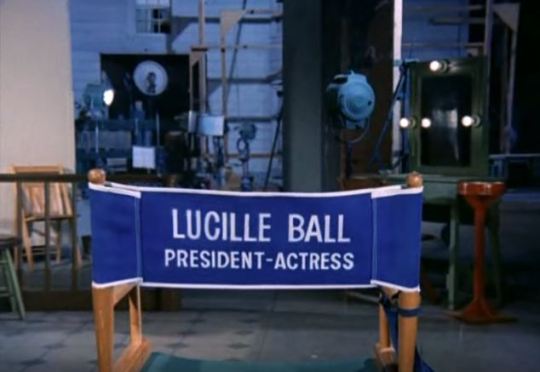
Lucille
Ball (’Herself’
/ Bonnie Blakely) was
born on August 6, 1911 in Jamestown, New York. She began her screen
career in 1933 and was known in Hollywood as ‘Queen of the B’s’
due to her many appearances in ‘B’ movies. With Richard Denning,
she starred in a radio program titled “My Favorite Husband” which
eventually led to the creation of “I Love Lucy,” a television
situation comedy in which she co-starred with her real-life husband,
Latin bandleader Desi Arnaz. The program was phenomenally successful,
allowing the couple to purchase what was once RKO Studios, re-naming
it Desilu. When the show ended in 1960 (in an hour-long format known
as “The Lucy-Desi Comedy Hour”) so did Lucy and Desi’s
marriage. In 1962, hoping to keep Desilu financially solvent, Lucy
returned to the sitcom format with “The Lucy Show,” which lasted
six seasons. She followed that with a similar sitcom “Here’s
Lucy” co-starring with her real-life children, Lucie and Desi Jr.,
as well as Gale Gordon, who had joined the cast of “The Lucy Show”
during season two. Before her death in 1989, Lucy made one more
attempt at a sitcom with “Life With Lucy,” also with Gordon.
‘Lucille Ball’ is the president of Consolidated Pictures. Bonnie Blakely is a television star.

Bob
Hope (’Himself’
/ Bill Blakely) was born Lesley Townes Hope in England in 1903.
During his extensive career in virtually all forms of media he
received five honorary Academy Awards. In 1945, Desi Arnaz was the
orchestra leader on Bob Hope’s radio show. Ball and Hope did four
films together. He appeared as himself on the season
6 opener of
“I Love Lucy.” He did a brief cameo in a 1964 episode of “The
Lucy Show.” He
died in 2003 at age 100.
Bill Blakely is a television star.
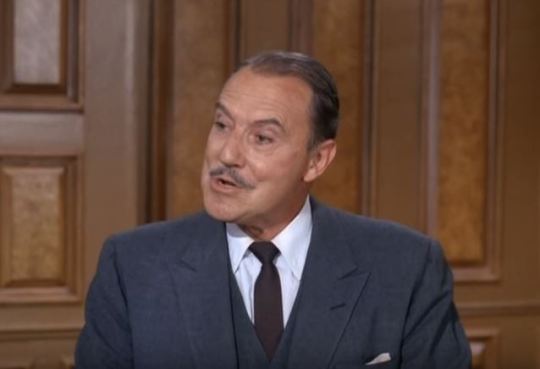
Gale
Gordon
(Elliott Harvey) was
said to be the highest paid radio artist of the 1930’s and was in
such demand that he often did two or more radio shows a day. His
professional collaboration with Lucille Ball started in 1938 as the
announcer of Jack Haley’s “The Wonder Show” (Wonder Bread was
their sponsor). He played Mr. Atterbury on Lucy’s “My Favorite
Husband” and was a front-runner for the part of Fred Mertz on “I
Love Lucy.” When scheduling prevented his participation, he
appeared as Mr. Littlefield, the Tropicana’s owner in two
episodes of
the show. In addition to Mr. Littlefield, he played a Judge in “Lucy
Makes Room for Danny,” a
1958 episode of “The Lucy–Desi Comedy Hour.” “The Lucy Show”
solidified his partnership with Lucille Ball for the rest of their
careers. He went on to play Harrison Otis Carter in “Here’s Lucy”
and Curtis McGibbon in “Life with Lucy.” He died in 1995 at the
age of 89.
Mr. Harvey
is the Chairman of the Board of Consolidated Pictures.
John
Dehner
(Mr. Henderson, below right) was seen alongside Ball and Hope in Critic’s
Choice,
released the year before this special. Dehner’s career started in
1941 and lasted until 1989, amassing nearly three hundred screen
credits. He died in 1992 at age 76.
Mr.
Henderson is a full partner in the ad agency Henderson Grisby Beane
and Smith.
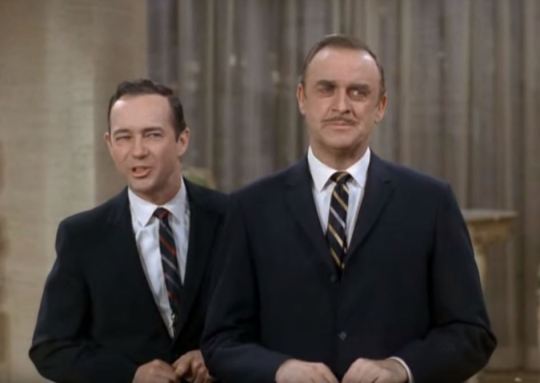
William
Lanteau
(Mr. Potter, above left) first
appeared with Lucille Ball in The
Facts of Life (1960).
In addition to an episode of “The
Lucy Show,” Lanteau
did four episodes of “Here’s Lucy.” He is best remembered
for playing Charlie the Mailman in the play and the film On
Golden Pond (1981).
Mr.
Potter works for Henderson Grisby Beane and Smith.
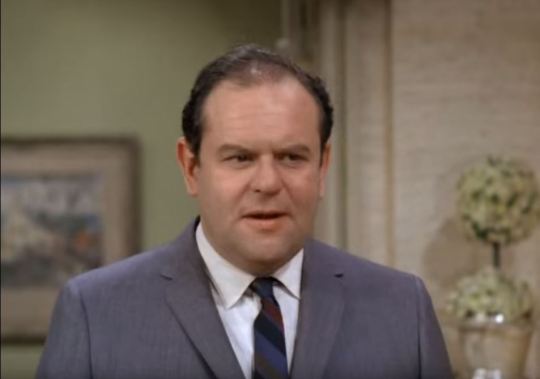
Jack
Weston
(Cash) started acting on television one month after the premiere of
“I Love Lucy” in 1951. He made three appearances on “The
Westinghouse-Desilu Playhouse” from 1958 to 1960. Weston’s final
screen credit was Short
Circuit 2
in 1988. He died in 1996 at age 71.
Cash
is Bonnie and Bill’s agent and manager.
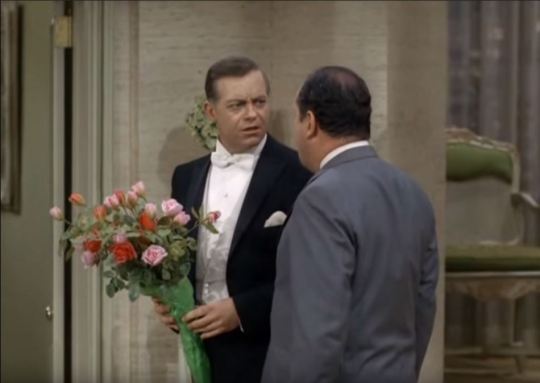
Max
Showalter
(Walter Creighton) was
born in Kansas in 1917. He got the acting bug as a toddler when
mother took him to the local theater where she played piano for
silent movies. He acted in 92 shows at the Pasadena Playhouse between
1935 and 1938 and made his Broadway debut in Knights
of Song. On
Broadway he played the role of Horace Vandergelder in Hello,
Dolly! more
than 3,000 times opposite such luminaries as Carol Channing, Betty
Grable, and Ginger Rogers. Showalter made more than a thousand TV and
film appearances. He was seen on two episodes of “The Lucy Show.”
Toward the end of his life he lived in Connecticut and died there in
2000.
Walter
is Bonnie’s fiancee, masquerading as her brother.
Joseph
Mell (Sam)
played
Bailiffs in “Lucy
the Meter Maid” (TLS S3;E7) and “Lucy
is Her Own Lawyer” (TLS S2;E23).
His first role on “The Lucy Show” was as a Butcher in “Together
for Christmas” (S1;E13).
Mell also appeared in a 1969 episode of “Here’s Lucy.” In 1971,
he was a Taxi Driver on “Lucy and the Lecher,” a cross-over
episode of Danny Thomas’s “Make Room for Granddaddy” in which
Lucille Ball played Lucy Carter, her character from “Here’s
Lucy.”
Sam
is a tailor working for Lucille Ball.
Sid
Gould (Sid)
made
more than 45 appearances on “The Lucy Show,” all as background
characters. He also did nearly 50 episodes of “Here’s Lucy.”
Gould (born Sydney Greenfader) was Lucille Ball’s cousin by
marriage to Gary Morton. He was married to Vanda Barra, who also
appeared on “The Lucy Show” and “Here’s Lucy.”
Sid
is a composer working for Lucille Ball.

Eddie
Ryder
(Mike) appeared
as Bones Snodgrass on the “Our Miss Brooks” (also starring Gale
Gordon) from 1953-54 under the name Eddie Riley. He was also seen in
“Lucy and the Submarine” (TLS S5;E22) in 1966. From
1961 to 1966 Ryder played Dr. Simon Agurski in 22 episodes of “Dr.
Kildare.” He died in 1997 at age 74.
Mike
is an executive at Consolidated Pictures. Ryder is the only actor who
gets a final credit using his character name (“Eddie Ryder as
Mike”), but the name is never spoken aloud in the show.
Danny
Klega (Russian
Translator) was a Czech-born actor who was often cast as German. His
first screen credit was 1962’s The
Four Horsemen of the Apocalypse
and his last was 1970’s Which
Way to the Front?
He died in 2015 at age 91.
John
Banner (Lieutenant
Gitterman, German Border Guard, below left) was
born in Vienna in 1910. He achieved television immortality for his
portrayal of the POW camp guard Sergeant Schultz in the TV series
“Hogan’s Heroes.” Ironically, Banner was a Jew and had been in
a German concentration camp himself. He was in all 168 episodes of
the series, the only actor aside from leading man Bob Crane to have
that distinction. His catchphrase as Schultz was “I
know nothing!” which
he repeated in a cameo as Schultz on “Lucy and Bob Crane” (TLS
S4;E22) in 1966. He died in his home city of Vienna in 1973.
Gitterman
was also the name used for Hans Conreid’s acting and music professor
character on “The Lucy Show.”

Rudy
Dolan
(German Border Guard #2, above right) was active from 1957 to 1964, often cast as
policemen and other officials.
Sally
Mills (TWA
Flight Attendant) played small roles on television from 1961 to 1971,
appearing on Desilu’s “The Andy Griffith Show” and “Gomer Pyle:
USMC.” For eight years, Mills was a spokesperson for Safeway
Supermarkets.
Stanley
Farrar
(Consolidated Board Member) was
seen on “I Love Lucy” in “Home
Movies” (ILL S3;E20) where
he played a character named Bennett Green, who actually appears with
him on this special and “Staten
Island Ferry” (ILL S5;E12).
He was seen in two celebrity-themed episodes of “The Lucy Show”
in 1964 and 1965, one of which also starred Max Showalter, who
appears in this special.
Bennett
Green
(Consolidated Board Member, uncredited) was
Desi Arnaz’s camera and lighting stand-in during “I Love Lucy.”
He did frequent background work on “The Lucy Show.”
Joan
Swift
(Consolidated Board Secretary, uncredited) made
six appearances on the “The Lucy Show” as well as two episodes of
“Here’s Lucy.” Her
final screen credit was in “Lucy’s Gets Lucky” in 1975.
Charles
Field
Roy
Rowan (Announcer,
uncredited) was the announcer for all of Lucille Ball’s sitcoms. He
even made a a couple of on camera appearances on “The Lucy Show.”
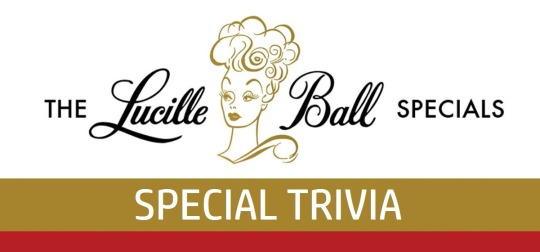

During
contractual negotiations with CBS for a second season of “The
Lucy Show,” Lucille Ball signed for $30,000 to
co-star in “The Lucille Ball Comedy Hour” to be aired in the
spring of 1964.
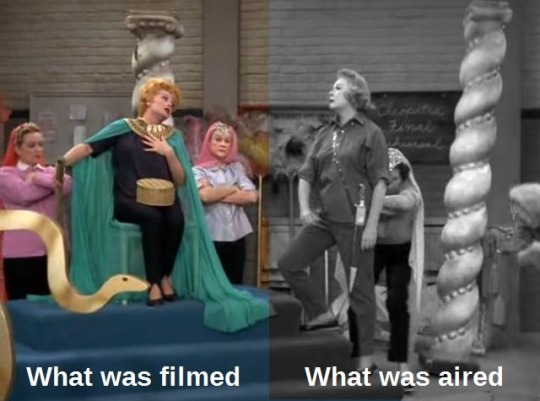
This
special was broadcast in color, one of Lucy’s first major appearances
in color on television. Although “The Lucy Show” had started
filming in color in the fall of 1963, CBS declined to air the series
in color until September 1965.
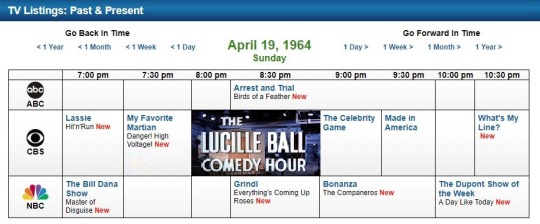
On
ABC, the second half hour of “Mr. and Mrs.” was up against an
episode of “Arrest and Trial” that also starred Jack Weston.
Meanwhile, NBC ran a show starring another funny redhead, Imogene
Coca, in “Grindl.” The special’s lead-in was another Sherwood
Schwartz show, “My Favorite Martian.”

Director Jack
Donohue also
served in the same capacity for 107 episodes of “The Lucy Show,”
and 35 of “Here’s Lucy.” His final screen credit was “Lucy
Gets Lucky” in
1980.
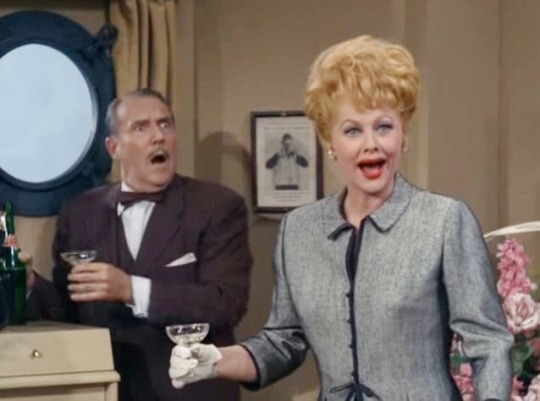
The
day after this special premiered, CBS aired “Lucy Is a Process
Server” (TLS S2;E27), also directed by Jack Donohue and co-starring
Gale Gordon.

“Mr.
and Mrs.” is based on an un-produced full-length stage play of the same name by
Sherwood Schwartz. It was boiled down to 30 minutes by Richard Powell
(teleplay) with special material by Arthur Julian, who were both
writers for Red Skelton during the 1950s. Sherwood
Schwartz
won his only Primetime Emmy Award in 1961 as the head writer for “The
Red Skelton Hour.” Schwartz
was the creative genius behind “The Brady Bunch” (1969-74) and
“Gilligan’s Island,” which would start airing in the fall of
1964. “The Brady Bunch” was based in part on Lucille Ball’s film
Yours,
Mine and Ours
(1968). Ball declined to make the TV version, opting instead to do
“Here’s Lucy.” At age 90, after his TV successes, Schwartz
returned to writing for the theatre with Rockers,
a play about a retirement home.
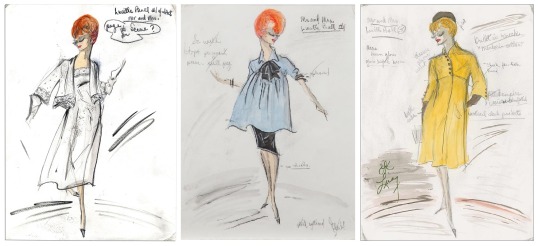
Lucille
Ball’s gowns for the special were by the Oscar-winning Edith
Head.
Head had dressed Lucille Ball in both of her film collaborations with
Bob Hope, Critic’s
Choice
(1963) and The
Facts of Life
(1960). Della Fox was the costumer and Kenneth Westcott was the props
master, both of whom also worked on “The Lucy Show.” Lucille
Ball’s usual hairstylist Irma Kusely and make-up artist Hal King were
also involved in this special. Jess Oppenheimer, creator and longtime
producer/head-writer of “I Love Lucy,” served as Executive
Producer.

Once,
during rehearsal, Bob Hope got too close to the camera, a fact
promptly noted by director Jack Donohue. Ball roughly shoved Hope to
his proper mark. “Lucy,”
said Donohue soothingly, “Please
don’t touch the actors. You never know where they’ve been.” A
little later, when Ball had her way with the handling of a scene,
Hope said, “That’s
what I like to work with—pliable producers and flexible
directors.” This
story appeared in the 1993 book Desilu:
The Story of Lucille Ball and Desi Arnaz by
Steven Sanders and Tom Gilbert.
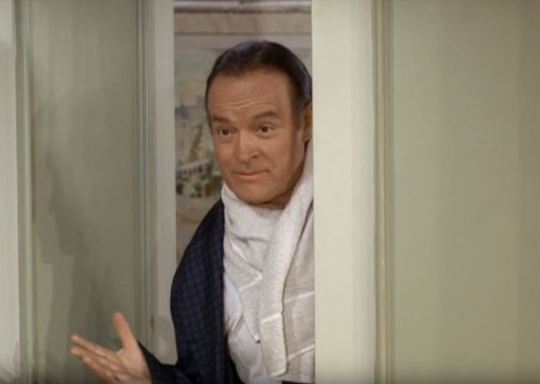
Bob Hope
and Lucille Ball rehearsed three full days, just as she would have her
regular half-hour television series. The show was then filmed before
a live studio audience with three cameras recording the action and a
laugh track added later to ‘sweeten’ the comedy. The next day, Hope
returned to film the single jungle scene in which Ball finally
locates him. The wrap-around story was true-to-life, not only because
it depicted Lucy as the president of a major studio (albeit not named
Desilu), but because it featured Bob as a world-traveler. Known in
show-business circles as “Rapid Robert,” Hope was famous
for dashing from a movie set to a benefit to a television special –
all in different cities. The day before Hope reported to Desilu for
rehearsals, he was in Washington on behalf of the 1964 Easter Seals
campaign. He had flown there after finishing a one-hour segment of
his own Chrysler TV series. As soon as he finished his stint with
Lucy, he was off to promote his latest movie. “While I’m
flying across the country,” Hope quipped at the time, “Lucy
will be talking about me. That’s why it’s a coveted role.” Lucy had her say in the matter: “All those scenes showing me
trying to catch up with Bob is from real life. If the world only knew
what I went through to get him on this stage to work with me in this
project!”

In
the special Lucille Ball is the President of Consolidated Studios.
Mr. Harvey (Gale Gordon) is the chairman of the board and represents
a bank that has extended a significant loan to the studio. Gale
Gordon was also playing a banker named Mr. Mooney on “The Lucy
Show” when the special was filmed.
Lucy:
“Just
because I’m an actress does not mean I’m not a good president!”

The
wardrobe designer in Lucy’s busy office is holding the actual Edith
Head costume renderings for Lucille Ball’s outfits in the special.

After
doing some checking behind Lucy’s back, Mr. Harvey discovers that Bob
Hope is not available until the week of July
4, 1976,
after he emcees the 200th Anniversary of America’s Independence. Twelve years later, the
writers were proved absolutely right when Bob Hope hosted the NBC TV
special “Bob Hope’s Bicentennial Star Spangled Spectacular” on
July 4, 1976.
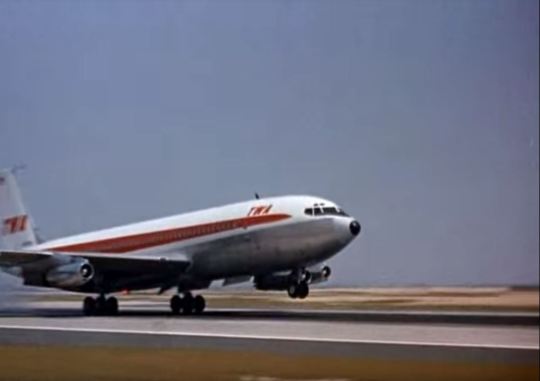
SAN FRANCISCO
Mr.
Harvey and Lucy fly to San Francisco to track down Bob Hope. Footage
of a jet landing was supplied courtesy of TWA, a carrier that went
out of business in 2001.
Lucy:
“This is not business, it’s show business.”
Mr.
Harvey: “Business
is business.”

In
San
Francisco,
the TWA flight attendant mistakes Mr. Harvey for Gary Morton, Lucy’s
real-life husband. She says she saw him on “The Ed Sullivan Show.”
Morton made two appearances on “Ed Sullivan,” in 1961 and 1962,
but it is hard to fathom how anyone could visually mistake Gale
Gordon for Gary Morton. The Flight Attendant informs them that Bob
Hope was in first class, while they were in coach, but he was rushed
aboard an Army bomber across the tarmac headed for…
ALASKA
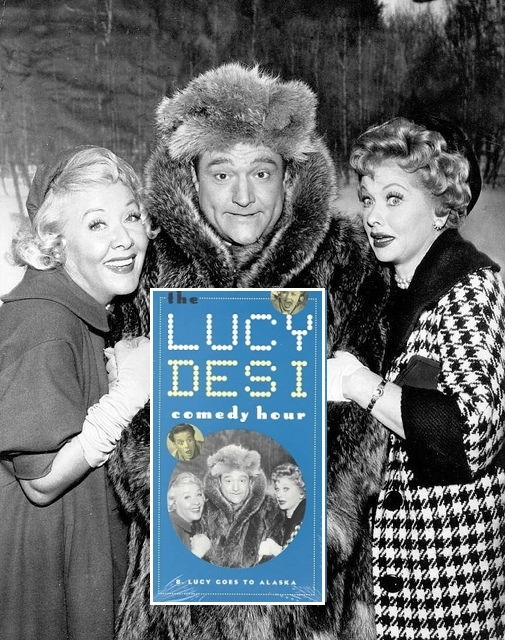
Lucy
and Mr. Harvey travel to Alaska
to track him down using a dog sled. This is not the first time
Lucille Ball has done scenes set in the 50th state. In “Lucy Goes To Alaska,” a 1959 episode of “The
Lucy-Desi Comedy Hour” when the Ricardos and Mertzes flew there to
perform with Red Skelton (coincidentally) in honor of their recent
statehood. In
Alaska, Lucy and Mr. Harvey find out Bob Hope has already gone to…
MOSCOW
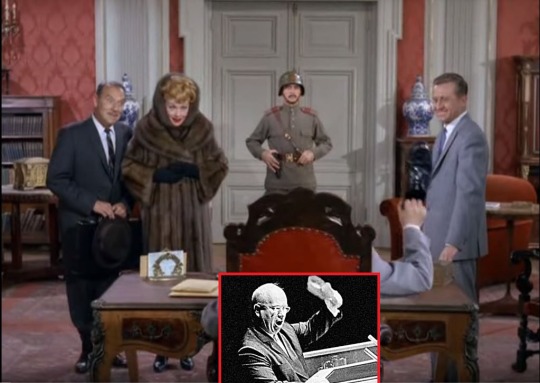
In a Kremlin office, a translator tells a man with his back to us
that Lucy and Mr. Harvey are looking for Bob Hope. The unseen man
laughs and pounds a shoe on his desk. During a 1960 meeting at the
United Nations, Soviet Leader Khrushchev
pounded his shoe on his desk in protest of a speech by Philippine
delegate Lorenzo Sumulong.
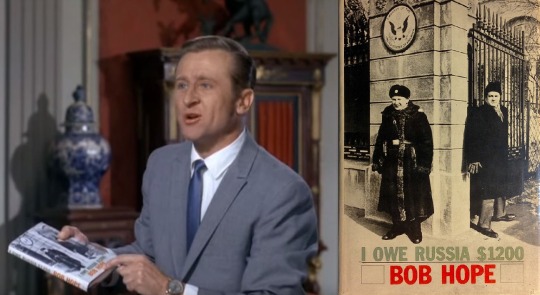
The
translator shows off an autographed copy of Bob Hope’s new book. This
is a plug for Hope’s 1963 book
I Owe Russia $1,200,
which Hope wrote with ghostwriter Mort Lachman after his trip to
Russia.
Lucy and Mr. Harvey learn that Bob Hope just left Moscow headed to…
GERMANY

Lucy and Mr. Harvey cross the border into Germany driving a single scooter. The
two other vehicles in the studio-filmed scene are Volkswagens, naturally.
The guards (one of them “Hogan’s Heroes” star John Banner, who did a cameo as Sergeant Schultz on a 1966 “The Lucy Show”) tell
them that Bob Hope has already been through and gone on to the
airport to…
THE PHILIPPINES
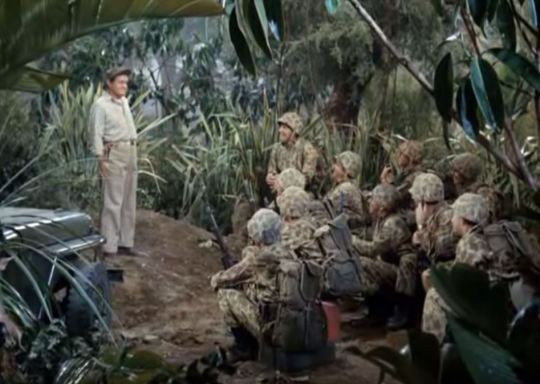
In
a jungle clearing, holding a golf club, Bob Hope is finally found
singing “Thanks
for the Memory” to
a group of American GIs in camouflage gear. The song was
written in 1938 by Ralph Rainger and Leo Robin for the film The
Big Broadcast of 1938 starring
Hope and Dorothy Lamour. It became associated with Bob Hope, who used
it as his theme song. He sang it at the end of his guest-appearance on “I Love Lucy” in
1956 and during his cameo in “Lucy Moves to NBC” in 1980.
As
Lucy explains the script of the special to Hope amid a downpour, the
show cross-fades to the first scene of…
“MR. & MRS.”
starring
Lucille Ball and Bob Hope as Bonnie and Bill Blakely, the stars of
America’s number one television show.

Fighting
off autograph seekers to get through their front door of their swanky
Manhattan apartment, Bill says
“I signed mine ‘Ringo’.”
He is referring to Ringo Starr, one of the Beatles. In 1964 they
became an international success when they made their first appearance
on “The Ed Sullivan Show.” The same date this special aired in
the USA, “Around the Beatles” was taped at Wembley Stadium for
ITV in England. It was aired in America on November 15, 1964.
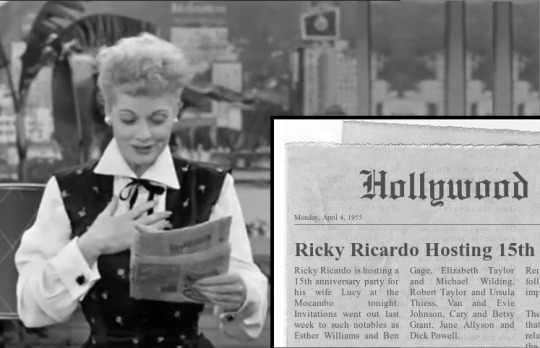
Bill
brags that a Cleveland newspaper compared him with Cary Grant. Grant’s name was often mentioned on “I Love Lucy” during their stay in Hollywood.

Walter
tells Cash he works at Peerless Department Store in Newark. His
father owns the store. (This implies that “Mr. and Mrs.” takes place in New York City, not Hollywood, where most TV shows are shot today.) They are opening a branch of their store in Japan, which will keep Walter out of the country for several months.

To
boost ratings the ad agency wants Bonnie and Bill to have a baby as
their characters and in real life.
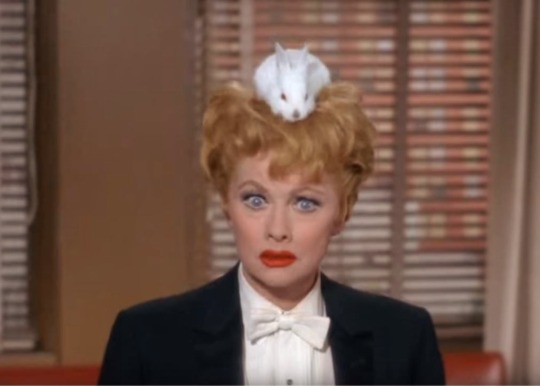
Bonnie
(indignant): “Having
a child happens to be an act of God.”
Mr.
Henderson:
“We
cleared this with the sponsor.”
Bonnie
and Walter head for the door to go to the opera.
Mr.
Henderson:
“Bonnie, please. The sponsor is expecting a baby.”
Bonnie:
“I’ll throw him a shower.”
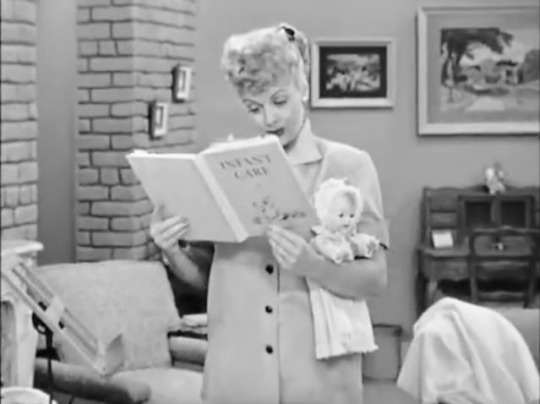
When Lucy Ricardo was to give birth on “I Love Lucy” in 1953, the story line had to be approved by the sponsor and the network. Lucy Ricardo and Lucille Ball gave birth at the same time – with the episode timed to coincide with Ball’s Cesarean. Lucy and Ethel also threw a ‘daddy shower’ for Ricky, to make him feel more a part of her pregnancy.

Eight
months later, Bonnie comes waddling into the living room extremely
pregnant. The underscoring plays “Funeral
March of a Marionette”
written by Charles Gounod around 1879. It is probably more familiar
as the theme tune of “Alfred Hitchcock Presents” (1955). Ball makes sure she stands in profile so the joke visually pays off. The tune was also used during “Little Ricky’s Pageant” (ILL S6;E10) in
1956 during the entrance of the gnomes.
Lucille Ball does the same
physical comedy business to lower herself into a chair that she did
as pregnant Lucy Ricardo. The Blakely apartment is a mess with baby
items and various gifts from fans. Bonnie claims they’ve received 300
pair of baby socks.
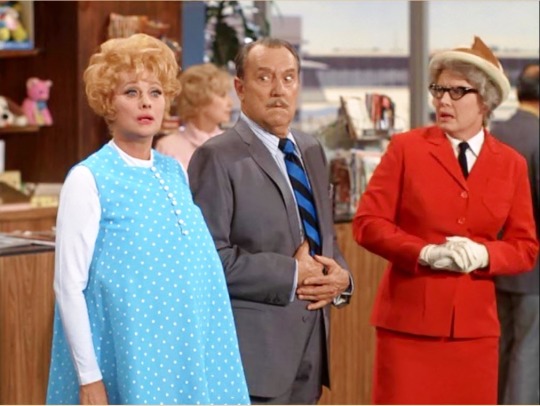
Walter
thinks Bill is the father and Bill thinks Walter is the father. They
realize that Bonnie is not really pregnant after all. Lucy Carter
will also fake her pregnancy (using a well-placed pillow) in “Lucy,
the Part-Time Wife” (HL S3;E14, above) in 1970. While filming “Mr. and
Mrs.” Lucille Ball was 52 years old.
Thinking
Bonnie is actually with child, Henderson’s agency runs a contest to
name the baby. The winning names are Gunther and Pandora.

Oops!
John Dehner (Mr. Henderson) says that name of his firm is “Henderson
Beane Grisby and Smith” instead of what Lucy previously said,
“Henderson Grisby Beane and Smith.” When Bob Hope mentions the
firm, he gets the names in the same order as Dehner, so likely Lucy
is the one who jumbled the list.
A
couple of times, it is apparent that Bob Hope is looking at cue
cards, not unusual for “rapid Robert” who had little time for memorizing lines.
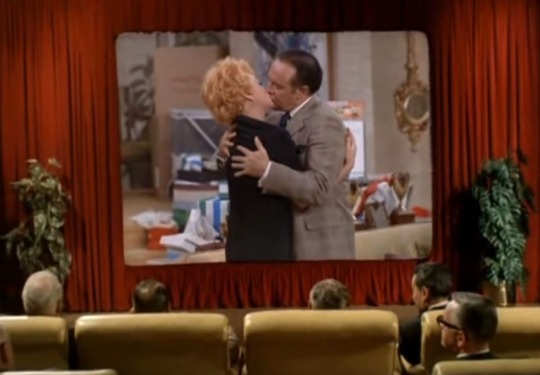
As
Bonnie and Bill kiss, the scene becomes the Consolidated Board of
Directors watching the special in a screening room. Lucy enters
dressed like a tramp, something she also did with Red Skelton in
“Lucy Goes To Alaska” in 1959. The flower in her lapel squirts
water in Mr. Harvey’s face and the credits roll.
This
Date in Lucy History
– April 19th

"The
Black Wig” (ILL S3;E26) – April 19, 1954
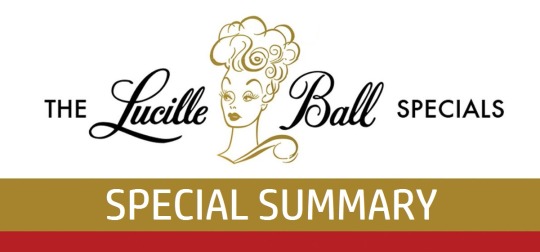
The first half of this rarely seen special is oddly different from the second. Lucy and Gale Gordon’s comic travelogue on ‘the search for Hope’ is clever and often laugh out loud funny. But the second half, boiled down from Sherwood Schwartz’s play, is a bit less engaging. The half hour starts well enough, but fizzles and feels very stage-bound. Still, lots of fun and an interesting footnote to “The Lucy Show” years.
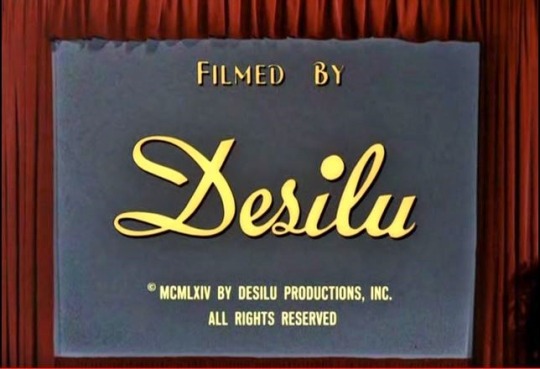
Leave a comment